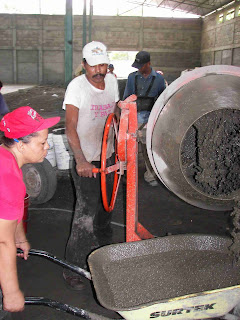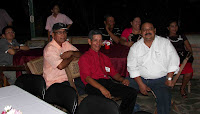Today and tomorrow Nicaragua is celebrating the Feast of the Immaculate Conception. It's such a beautiful tradition and so important to Nicaragua that we thought we'd re-publish an earlier blog on the subject.Duri

ng the month of December the people of
Nicaragua are celebrating the Feast of the Immaculate Conception, called
Purísima, which is by far the largest holiday in the country.
The celebrations are loudest on the 7
th of December during the
Gritería,or Shouting, which is a bit like Christmas caroling and Trick-or-Treating rolled into one.
Families show their gratitude for miracles that the Virgin Mary has granted them by setting up altars to the Virgin in front of their houses.
Neighbors come to the altars, sing traditional songs to the Virgin, and then are given gifts – they go from altar to altar, often filling sacks with their bounty.
I am always so humbled by this extreme show of generosity, often the poorest neighborhoods give the most – and most practical – gifts.
Families save all year to pay tribute to the Virgin Mary.
Throughout the year they buy as they can: woven rattles,wooden noisemakers, plastic containers, soap, bowls, buckets.
In early December days are spent in preparation: making
chicha (a sweet corn drink the color of Pepto Bismal), ginger candy,
nacatamales and cookies; buying sugar cane,
nancite fruits, oranges and firecrackers.
On the 8
th of December a table is put out in front of the house and covered with a cloth.
On the table goes a polished statue, or a gold-framed picture of the Virgin Mary hovering with celestial angels.
Around the image white baby’s breath flowers are arranged with candles, tinsel, balloons, and the whole altar, sometimes quite elaborate, is framed in palm fronds.
Sacks of gifts are hauled out and placed near the altar, along with buckets of
chicha-filled bags, fresh
nacatamales and fruit – many times whole rooms of the house have been occupied by these gifts.
By evening, the men of the families are ready: at 6 o’clock on the dot, they light the mortar launchers and fireworks pierce the air at once, all over the country.
It sounds like a war zone.
Then mariachi and brass bands start up, and groups of families weave through the streets carrying sacks, stopping at each altar to shout
“¿Quién causa tanta alegría? ¡La concepción de María!” “Who causes so much joy?
The conception of Mary!”
¡Que viva María! ¡Que viva! 
Then each group, paused before the altar, sings traditional Purísima songs to the image of the Virgin Mary, as the family with the altar begins to pass out gifts. Those who have received good fortune and even miracles show their gratitude to the Virgin Mary through their generosity to Her people. It seems to me an entirely appropriate way of showing thanks – by giving with wild abandon to all those who show up on our doorsteps. -- Becca








































